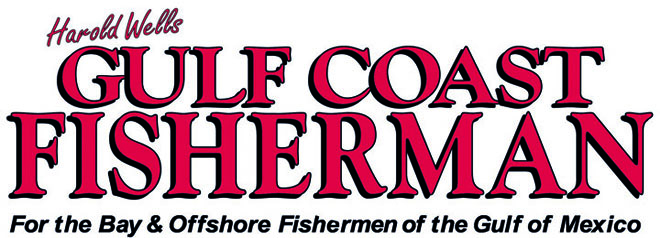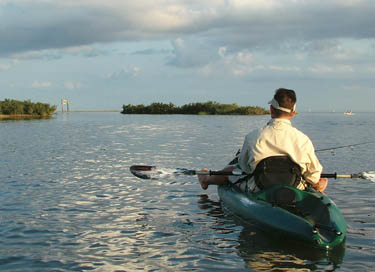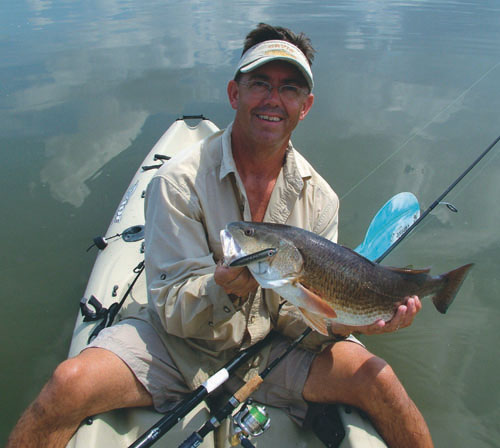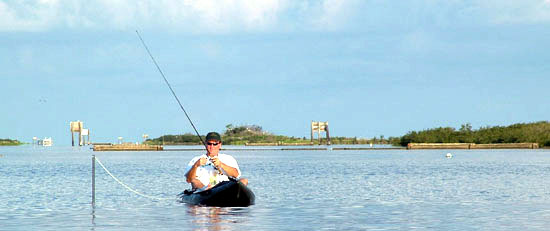
The Saltwater Magazine for Gulf Coast Fishing!
FISHING FORECASTS | FISHING CALENDARS | ARTICLES | SUBSCRIBE
Search Gulf Coast Fisherman's
Web Site
Past articles, specific
places or fish, etc.

Take a Cajun Sleigh Ride
by Al Rogers
| CURRENT
MOON lunar phases |

Kayaks offer anglers new shallow water fishing opportunities
FOURCHON, Louisiana. The "Nantucket Sleigh Ride" was a term coined by American whalers in the early 1800s to describe what happened after their prey was harpooned. It was a wild and often deadly ride. The initial strike was not intended to kill the whale, but to attach the leviathan to a smaller whaling boat.
I knew this, although I've never been anywhere near this tiny island in the north Atlantic Ocean. The thought of whalers battling a monstrous sea creature that was larger than the boat they rowed was fascinating. Captains Danny Wray and Mark Brassett seized my attention when they mentioned the "Cajun Sleigh Ride."
"What are you talking about?" I asked.
The two men chuckled and led me aboard their mother ship, a 28-foot custom pontoon boat moored at Brassett's "camp," in the exclusive waterfront community of Point Fourchon.
Jack, my 14 year-old son, boarded the all-aluminum boat that carried a neatly stacked fleet of six 14-foot kayaks. I remained silent, patiently waiting for a response.
"You'll find out soon enough," said Wray.
After fishing the northern Gulf Coast for nearly 40 years I thought I had seen and done it all. My work has taken me from Key West to Central America - from the shallow flats off the Texas coast to the extreme depths 100 miles off the mouth of the Mississippi River. I knew immediately that this day would be a new experience. But I didn't realize that it would forever change my ideas about coastal angling.
Personally, there is nothing more exciting that watching a 12-pound redfish slam a topwater plug in six inches of water. If you've seen this then you know what I'm talking about. As the popper, chugger or walking bait disappears in a frothy boil, your hair seems to stand up and your heart skips a beat. I have forgotten trips where I have limited out on school trout. But I can recall explosive topwater strikes that happened 20 years ago.
 Wray and Brassett, owners and operators
of Calmwater Kayaker, know this well. Here they can easily access to the
best fishing in the entire Terrebonne estuary. Anglers can find year-round
action on speckled trout, redfish, flounder and many other species. But
what sets Calmwater Kayaker apart from the rest is how they do it. Their
guests get to experience incredible fishing and breathtaking scenery from
their own boats.
Wray and Brassett, owners and operators
of Calmwater Kayaker, know this well. Here they can easily access to the
best fishing in the entire Terrebonne estuary. Anglers can find year-round
action on speckled trout, redfish, flounder and many other species. But
what sets Calmwater Kayaker apart from the rest is how they do it. Their
guests get to experience incredible fishing and breathtaking scenery from
their own boats.
From Brassett's dock we headed up Bayou Lafourche into Devil's Bay. Here I saw a series of small mangrove islands with shell banks. Pristine waters surrounded the small landmasses and evidence of sea life was everywhere. Large schools of mullet moved through gin-clear shallows while small crabs scurried across the shoals.
It did not appear like Louisiana waters.
"We call this area 'The Keys' because it looks so much like south Florida," Brassett said. It's just like fishing the other interior and coastal areas in Louisiana," Brassett said. "You look for baitfish, shrimp and structure. But it is very different from other nearby estuaries."
Staring at the light tackle in the rod holders and the kayaks that weighed less than 65 pounds each, I thought about the "sleigh ride" analogy. And it all began to make sense.
Fall Fishing
There was a crisp feel to the morning air, evidence that fall was approaching. The days were becoming shorter, paving the way for cooler, more comfortable temperatures. To Wray and Brassett there is no better time of the year that to stalk the big redfish and speckled trout in this area.
Generally speaking, the Terrebonne estuary stretches from Cocodrie to Fourchon. It includes the legendary Timbalier Island chain and Terrebonne Bay. We were now in Little Lake. Because of the hard shell and sand bottoms the water remains clean, even in windy conditions. The hard bottom anchors the tiny islands and keeps the areas of broken marsh in place.
Like most Louisiana natives I've been in my share of pirogues. This however, was my first time in a kayak. I was skeptical. But I found the stability impressive even with my 225-pound frame. Kayaks designed for the recreational saltwater angler are nothing new. But the popularity of targeting redfish in extreme shallow interiors has brought on new designs and innovations in these skinny water vessels.
Calmwater Kayaker uses Wilderness Ride kayaks. These vessels are designed with a tunnel hull that enables them to literally float in a puddle of water.
Jack wasted no time jumping in a kayak and heading toward a grass shoreline. He made it clear that he wanted the first "sleigh ride."
Brassett laughed and wished him luck.
"I think that's what our guests like most about these trips," he said. "You've got complete freedom and can come and go as you please. We will go with the less experienced anglers and give them pointers. But it's all up to them."
Meanwhile Wray and I carefully boarded two other kayaks that were packed with the bare essentials a rod, reel and small tackle box with about a dozen assorted plastics, two MirrOlure Top Dogs, jig heads and a popping cork. Other items on board included a life vest, "stab anchor," and fish stringer.
We paddled quietly, moving toward a disturbance in the water just 100 yards off our bows. We moved in closer next to a flock of seagulls that hovered over a school of feeding fish. The school and the gulls did not disperse. Because of the stealthy nature of kayaks, they are believed to be the most effective method of fishing speckled trout under the birds.
With chartreuse plastics suspended under popping corks we caught school trout on nearly every cast. Most of the fish specks were it the 12- to 14-inch range and engulfed the Bass Assassins as soon they hit the water. After boating 18 keepers the school moved on and we pulled anchor.
An Unforgettable Experience
Kayaks are becoming more popular for many reasons. They are effective because anglers can quietly access areas that are impossible to reach in larger boats. Another reason is the economic considerations. The rising costs of fuel are prompting many anglers to explore alternative methods. And while new fully rigged bay boats can costs more than $30,000, a good kayak can be purchased for $500 to $600.
But the fishing experience is a huge factor. The view is spectacular.
We scoured the banks for tailing reds but saw nothing. So Wray suggested we try a deep holes that he knew would be holding bigger fish. The tide was beginning to change so we anchored at a shelf and "tight-lined" plastics. After five casts Wray felt that the fish were on the bottom and would be feeding slowly.
On Wray's next cast he threw out and let the bait sink to the bottom. Slowly he moved it until a big fish struck. Unlike the summer trout we had caught just weeks ago this one ran deep, fighting more like a redfish or black drum. But when the trout's big yellow mouth emerged from the water he swung the fish into the kayak. This was significantly larger than what we were catching earlier. We estimated that the 19-inch fish was in the three-pound class.
I followed his lead and allowed my bait to sink to the bottom. And on the third twitch the bait seemed to just stop and I set the hook on another big speck. We managed to put nine more on the stringer while losing two Wray estimated to be in the five-pound class.
"In a kayak there are no boundaries," he said. "With a three-inch draft we can get into areas that most of the other boats just can't."
Wray said he has known Brassett since high school. They both own their own camps in Fourchon and in Grand Isle. After fishing the estuary for years they explored dozens of different type of boats capable of accessing the shallows.
"One day Danny brought over two kayaks and said 'let's go fishing," Brassett said. "We were in Grand Isle and I was a little apprehensive at first about going out into the surf. Eventually we got out to the rock jetties and we both caught our limits of speckled trout and redfish."
Brassett said he was convinced from that day. They later purchased the custom pontoon boat that would be used to transport their fleet of kayaks. It was the beginning of what would soon become Calmwater Kayaker.
Wray and Brassett are always dreaming of ways to improve and rig out their fleet of kayaks. After Hurricane Katrina devastated the areas the access to one of their favorite beaches was closed. So they invented a watercraft the pair dubbed "The Kayakamaran." It consists of two kayaks tethered together with rope and PVC pipes. This catamaran-type boat enabled them to get across very choppy open water and access their beaches.
"It's pretty neat," Wray said. "We don't use it on our charters."
When they tried to have the craft licensed by the state, the Louisiana Department of Wildlife & Fisheries (DWF) did not have a category to register the boat in. The problem was eventually worked out.
During the next two hours we picked up several more trout, a black drum and flounder. But the big redfish we sought had not yet made an appearance. But then it happened. At noon shouts were heard in the distance. They came from a 14 year-old who had hooked up with a big one. After patiently working a chrome Top Dog down the banks of an interior cut, a big red had slammed his lure.
Wray and I paddled swiftly to get a better view. From a distance we watched Jack's kayak being turned 180 degrees as he fought the redfish. The redfish pulled the young angler to the mouth of a cut before tiring and rolling over at the side of the kayak. Jack slipped the stringer through the redfish's gill plates and hoisted it over the gunwale.
"That's it," Wray said. "That's the Cajun Sleigh Ride."
The bronze sides of the redfish glistened in the sun. Jack beamed with pride, admiring the fish.
"Fun, wasn't it?" Wray asked
"Yea, like a roller coaster. I wanna to again," he said.
For more information on fishing excursions, lodging, etc. call Calmwater Kayaker at (225) 673-1764; or (225) 281-0863; or visit their website: Calmwaterkayaker.com.
Al Rogers is a multi award-winning outdoors writer, photographer and columnist whose work is published regularly in magazines, newspapers and websites across the northern Gulf Coast in Texas, Louisiana, Mississippi, Alabama and Florida.


